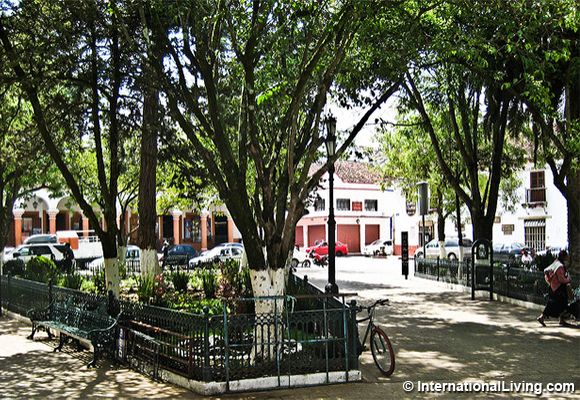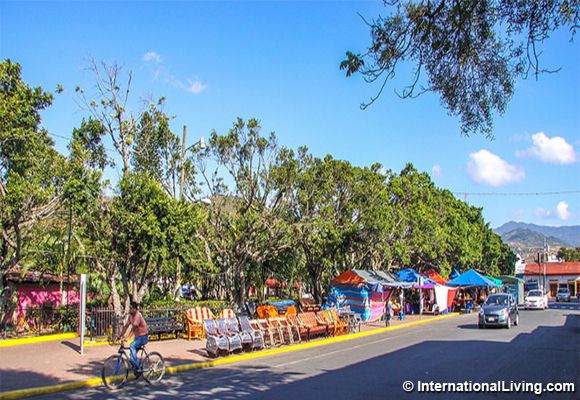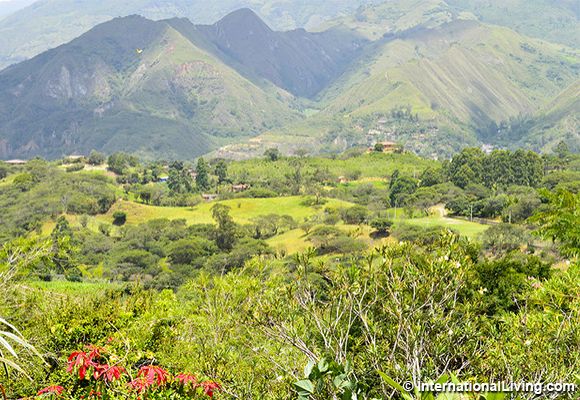By Suzan Haskins and Dan Prescher https://internationalliving.com
If you’re looking for the perfect climate in which to make your retirement home…take our advice and follow the coffee trail. Because the same conditions that makes for great coffee growing also make for great year-round living.
It’s all about elevation, latitude, and a good blend of rainfall and sunny days.
For instance, near the equator, coffee grows best at elevations of 3,600 to 6,300 feet above sea level. In subtropical regions on either side of the equator, elevation requirements range from 1,800 to 3,600 feet above sea level.
In both areas, the cool (but never too cold) rainy, and warm, dry seasons must be well defined, so that the coffee beans can flower and grow during one season…and mature and be harvested during the other.
And when this perfect climate emanates from a scenic locale that also happens to be ultra-affordable, it’s the perfect combination for a top-notch retirement destination.
Here are our top six picks for excellent, perfect-climate, coffee-growing areas where you can live a great retirement lifestyle:
Mexcio
You’ve likely been to Mexico, or know somebody who has. Millions and millions of tourists each year safely visit its gorgeous world-class beaches. (Mexico has just earned the designation as the eighth most-popular tourist destination in the world.)
But Mexico isn’t just beaches. In fact, it’s home to the Sierra Madre mountain ranges, that run from north to south through the country. In these highland regions, you’ll find charming colonial towns and a perfect year-round climate.
Some of these are perfect coffee-growing regions, especially in select areas of Veracruz, Oaxaca, and Chiapas states. You’ll find expats living in all these places, and more.

San Cristobal de las Casas, Chiapas. Mexico.
The most popular destinations in the highlands for foreign retirees are, arguably, San Miguel de Allende and the Lake Chapala area, which is where we’re currently living. Especially at “Lakeside,” it’s easy for a couple to live well for $2,000 a month or less, rent included.
While neither San Miguel nor the Lake Chapala area offer perfect coffee-growing conditions, you will find a most agreeable year-round climate. At about 5,000 feet above sea level, Lakeside is at the same elevation as Denver, Colorado, and the same latitude as Hawaii. Daytime temperatures are typically in the 70s and 80s year-round.
While the state of Jalisco, where Lake Chapala is located, isn’t known for coffee…it is the world’s best tequila-producing region.
Nicaragua
A quickly emerging tourism and retirement destination—Nicaragua offers a rugged Pacific coastline with miles and miles of beach after untouched beach, as well as warm, gentle waters of the laidback Caribbean, and its little-known Corn Islands.
Here you can spend your days enjoying the cultural ambience of colonial towns such as Granada or León, taking a cruise on massive Lake Nicaragua or down the gorgeous San Juan River, or even climbing the flanks of a perfect cone-shaped volcano.
If you’re not a fan of the tropical climate, head up to the cool-weather mountain town of Matagalpa, one of the country’s undiscovered gems. This affordable expat haven, in the heart of Nicaragua’s coffee country, is home to 300 to 400 expats—mostly American and Canadian.

Parque Ruben Dario, Matagalpa, Nicaragua.
In Matagalpa, nestled in nature near pristine lakes, rivers and lush, fertile forests, your surroundings will be green all year-round. The climate is mild and average temperatures range from 59 F at night to 74 F during daytime.
Thanks to this temperate climate, you will never need heat or air conditioning, and your cost of living will be very low. A couple can live comfortably for $1,200 a month. A three-bedroom, two-bathroom house with a garage and yard can be rented for only $300 a month. Just $75 will cover your utilities for a month and $400 your grocery bill.
And if you’re a cigar aficionado, you’ll be happy to know that Nicaragua is also known for tobacco…and rum lovers will love Nicaragua’s award-winning Flor de Caña rum.
Costa Rica
Costa Rica is indeed a “rich coast.” That’s what Christopher Columbus called this land that he “discovered” back in 1502. If you’ve been to Costa Rica, you probably went directly to one of the country’s many beaches, where tourists flock to the shores and spend their days swimming, sunning, and surfing.
But Costa Rica too, is far more than just beaches. For decades, expat retirees have been streaming to its Central Valley, where almost three-quarters of the population lives. Here, you’ll find easy access to the international airport, first-rate hospitals, excellent shopping (with designer or boutique alternatives), lots of great restaurants, and more.
And then, of course, there’s the climate. With elevations ranging from 3,000 to 5,000 feet, you can pick the perfect spot with a mild climate to suit you. Again, air conditioning and heating aren’t needed—daytime highs are usually in the 70s F or low 80s F, and nights are typically in the 60s F.
See a trend here? The perfect combination of elevation and latitude is well suited to human habitation. And to the cultivation of great coffee…which you’ll definitely find in Costa Rica.
Some of the best coffee beans in Costa Rica are grown near the Central Valley town of Cartago. The rich volcanic soils and mountain elevations provide the perfect environment and you’ll enjoy not just a low cost of living ($1,700 a month for a couple, rent included) but a full-flavored liquid cup of heaven any time you like.

Cartago, Costa Rica.
Panama
Panama is a small S-shaped country with much to offer retirees, including the world’s best retirement program that offers you a host of incentives and discounts on everything from utility bills to restaurant meals, travel, medical costs (including both prescriptions and over-the-counter medications), and much more.
As you likely know, back in 1904, the U.S. stepped in to spearhead the building of the Panama Canal, and since then the U.S. has enjoyed a big presence in Panama. That’s one reason you’ll find a good many English speakers in Panama…in the sparkling Panama City, along the gorgeous beaches on both Pacific and Caribbean coasts, and in the highland coffee-growing region.
Most of Panama’s excellent coffee comes from the Chiriquí province where you’ll find two towns in particular, that are popular with expat retirees. The best-known of these is the pretty town of Boquete, nestled amongst tree-covered rolling hills and deep valleys cut by quintessentially babbling brooks, the Barú volcano looming above it all, often obscured by clouds.
This bustling town of around 20,000 sits at an elevation of just below 4,000 feet. So, despite being in the tropics, daytime temperatures are consistently in the 70s F and 80s F, cooling off at night. You can leave your windows wide open to let in cooling breezes of fresh clean air.
Once again, that means there’s no need for heat or air conditioning, keeping costs down. A couple can live in Boquete…all in…for around $2,000 a month.
The nearby town of Volcan has also become popular with expats looking for similar surroundings, climate, and affordability…but with a smaller town feel.
Some of the world’s best coffee is grown in the highlands of Panama’s Chiriquí province, including the ultra-expensive awarding-winning Geisha variety. But don’t worry, there are plenty of great coffee varietals grown in Panama, and for just $1 in a local sidewalk café, you can enjoy a rich cup o’ java that might cost you $8 at a Starbucks in the U.S.
Ecuador
Ah, Ecuador… There may be no more agreeable climate on the planet than in Ecuador’s Andes Mountains…especially in those regions where coffee is grown.
We lived for many years in the picturesque village of Cotacachi in northern Ecuador, and our favorite coffee came from the nearby Intag Valley. Café Rio Intag is a rich, dark blend of tasty goodness and comes packaged in a cool burlap bag that can be re-purposed over and over. (We saved and used them as small gift bags.)
Another place great for both coffee growing and expat life—is the province of Loja in southern Ecuador. A friend living in the town Vilcabamba—known for its healthy “vortex” that allows its citizens to live well into their 100s—once brought us a bag full of green coffee beans he had picked from his farm. We had great fun experimenting with roasting and brewing coffee from them.

View of the mountains, Vilcabamba, Ecuador.
Known as the “Land of Eternal Spring” for its temperate climate where almost anything can be grown, in Ecuador you’ll also find a very low cost of living. We owned our own home, so we didn’t pay rent, but still, it was hard to spend more than $1,400 a month, and that included dining out often, our HOA fees, and more.
Colombia
Who hasn’t heard of Juan Valdez? There’s a very good reason you know that name. Juan Valdez was “created” by Madison Avenue in 1960 as a spokesperson for Colombian coffee.
Not that Colombia needs much help in that regard. The country is known for growing some of the best coffee on the planet. There’s even an area in the heart of Colombia known as the “Coffee Triangle.” This is where most of Colombia’s rich Arabica coffee beans are grown. And the scenery couldn’t be more beautiful, nor the climate more amenable. Gorgeous, green hills, clear-water creeks, and vistas of lush coffee-covered valleys stretching for miles and miles.
One of our favorite towns in the Coffee Triangle is Salento, with its pretty historic buildings painted in pastel shades. Colombian tourists have enjoyed visiting here for decades, and today, a rapidly growing number of international travelers are also finding their way here. (Rent a nice apartment in the center of town for $200 to 300 a month or buy a home for an average $50,000 to $80,000.)
Pereira and Manizales are larger cities in the Coffee Triangle and they too, are worth a look. Manizales is a university town and particularly loaded with cultural attractions, including museums, theaters, huge parks, excellent hospitals, and more.
About how much does it cost to live in Colombia? Far, far less than you might expect for a thoroughly modern country…one of the most progressive in Latin America. Most expat couples report that they live very comfortably on $1,500 to $2,000 a month, depending on whether they own their own home or not.
And a single can live on even less. One single woman we know tells us her monthly expenses are less than $1,000 a month…and that includes $300-a-month rent for her gorgeous, newly renovated apartment in the historic center of a beautiful UNESCO-protected city.
The takeaway: Wake up and smell the coffee. If you’re looking for the best place for your overseas retirement, and a near-perfect, year-round climate is at the top of your list, one of the easiest strategies is to follow the coffee trail.
This article comes to us courtesy of InternationalLiving.com, the world’s leading authority on how to live, work, invest, travel, and retire better overseas.
RELATED ARICLES